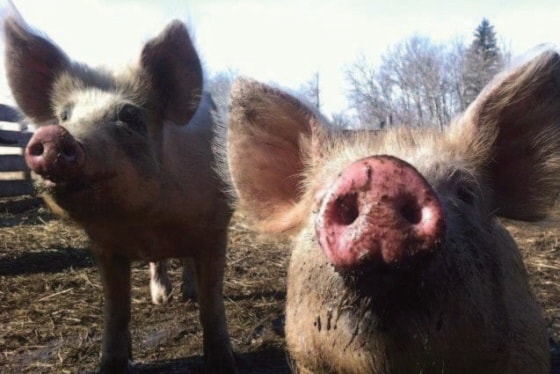Growing up on a farm, Jesse Connon grew to expect a certain standard in the food he ate.
His family raised all sorts of animals, from chickens at the smallest to cattle at the largest. He and his siblings helped care for the animals up until they were butchered, ending up on the family’s plate at meal time.
As an adult, Connon moved away from the farm. His meat started to come from grocery stores. And he found himself not all that impressed.
“We were dissatisfied with the quality of the meat that was available to us, I guess,” he said. “So we started doing some research into it. Different breeds, the traits they carry.”
Connon and his family live just outside of Castor on a parcel of land. They were raising chickens already, and Connon wanted to expand. Cattle would be too difficult since he was often away working in the oilfield, and his wife, Krista Gordon, was a town girl who’d never raised animals before.
But pigs could be the answer.
“We wanted to basically make the best cut of pork for ourselves,” Connon recalled. “We never really expected to get into selling any of it.”
Right off the bat, Connon decided he wanted to not raise his herd of pigs the way the industrial farming business did. He didn’t want to make his pigs big as fast as he could as cheap as he could, ensuring wide profit margins. No, he wanted to raise pigs that tasted good, were fed healthy, raised free to roam and not pinned in small pens, and went from piglet to butcher as happy, unstressed animals.
“That’s another thing we believe,” he said. “Happy pigs – happy animals – are going to make the best quality meat. Animals not raised in bindings, (animals) born in open areas where they can move around make better meat.”
Besides the happy pork factor, the range-roaming herd of swine comes with other benefits.
“Something about the pigs keeps the coyotes away,” Gordon said.
Raising their animals out of pens, where as many can be crammed as possible, has resulted in healthier pigs, from piglet to sow and boar.
“With confinement there’s so much risk for diseases, so (the industry) has to use more antibiotics to stay healthy,” Connon said.
Connon and Gordon feed their pigs grains like wheat, oats and barley, in addition to the natural forage of grasses the pigs chow down on when in the field.
The feed they purchase for the pigs comes from a feed mill, and Connon knows what is going into the feed.
“There’s no animal byproducts,” he said. “No hormones, no antibiotics.”
While Connon would like to be able to certify the pork as organic, because the feed mill he uses isn’t, he can’t guarantee absolutely that the pork he eventually sells is organic.
What he does guarantee, though, is that anything he sells hasn’t been knowingly fed antibiotics, hormones or animal by-products.
Connon raises Berkshire pigs for the most part, though one of the breeding boars is a Berkshire cross with a large black.
The project – raising their own pigs – began as something the family was doing to control the quality of meat entering their own tummies, but as friends and friends-of-friends had a chance to sample the smokies, sausages, bacon and various pork cuts, demand and pressure started to build up on Connon and Gordon to sell their products.
Enter Battle Boar Farms, the business name the two chose. Their logo, a cute pig-face on a shield with mace and axe, is designed to look like a coat of arms.
“We started with five pigs, three males and two females,” Connon said.
“Now we have four boars, with one being our main breeding boar, and six sows. We have about 40 piglets right now.”
The family, able to do their own butchering when the food was just for them and close friends, had to find someone to take that part of the production chain off their hands. They ended up choosing Provost Packers out of Provost, on the Alberta-Saskatchewan border.
”Once we started (selling our pork), it had to be government inspected, and at government inspected facility,” Connon said, explaining the Canada food guidelines.
Finding a butcher wasn’t difficult, Connon said, but noted that, “being able to find a butcher that we liked and was able to work with us and give us the product back that we expected was awesome.”
While Connon is at work in the oil field, Gordon remains at home, a stay-at-home mother to their kids and the herd of pigs. She is out early every morning with the older kids, checking the fences, watering and feeding the pigs, and making sure all’s in order.
Chores in the evening occupy her and Connon and the kids as well.
It’s become a family endeavour, one that’s drawn everyone together and has helped teach the younger members of the family responsibility.
For Gordon, who’d never raised an animal other than the family pet, she’s found a new passion.
“I really enjoy it. I never thought I would,” she said.
Connon finds pleasure in helping others discover what good food tastes like, not the factory-produced cuts found in the grocery store or in the mass-produced meat markets.
“We have had people who don’t really understand (why we do this),” he said. “They think a cut of pork is a cut of pork. A big part isn’t just the pigs being raised out of confinement, the happy pigs if you will, it’s the cut of meat and meat quality. Some of those people who have said a cut of meat is a cut of meat after trying our stuff realize it’s not the same. And that’s good – this sort of small grassroots change can eventually change the industry.”
